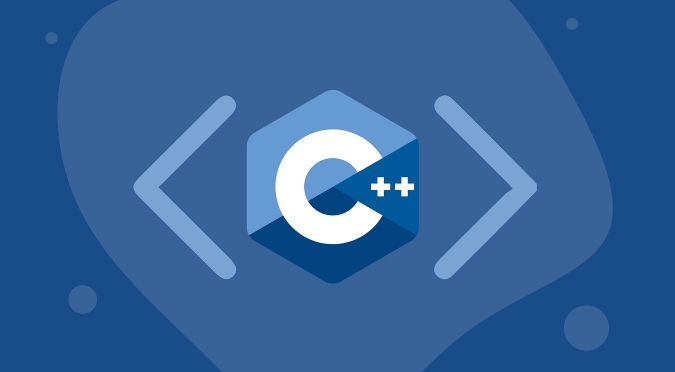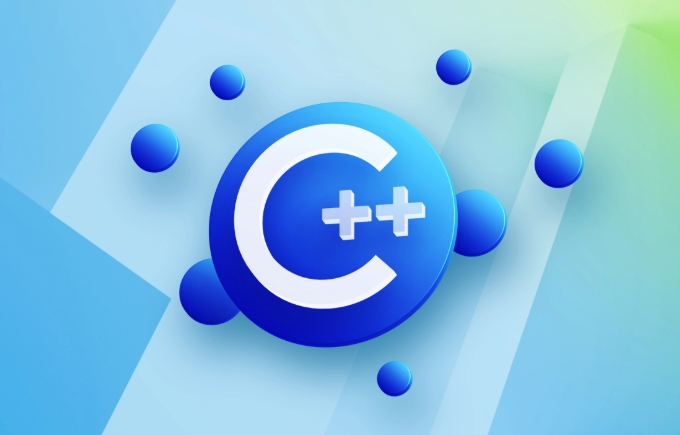What is STL (standard template library) in C? It contains four components: container, algorithm, iterator and function object. Containers such as vector, list, map and set are used to store data, algorithms such as std::sort() are used to operate elements in containers, iterators connect algorithms and containers, and function objects are used to customize algorithm behavior. Why use STL? 1. Save time: Direct calls have been efficiently implemented; 2. Efficiency: The code has been optimized and widely tested; 3. Flexibility: The template supports multiple data types; 4. Portability: Cross-platform compatibility as part of the C standard. How to get started with STL containers? Taking vector as an example, you can introduce the header file through #include, add elements using push_back, access the elements through [] or at(), and check whether they are empty before accessing. Common errors include forgetting to include header files, misuse of iterators, unreasonable use of const, and excessive use of dynamic memory. Mastering the basic containers and usage can improve coding efficiency and stability.

STL in C stands for the Standard Template Library . It's a powerful collection of pre-written C code that helps developers handle common data structures and algorithms without having to build them from scratch.

What's Included in the STL?
The STL is made up of four main components:

- Containers : These are objects that store data. Examples include
vector,list,map, andset. - Algorithms : These are functions that operate on containers, like sorting or searching. For example,
std::sort()can sort elements in a container. - Iterators : They act as pointsers to connect algorithms with containers. You use them to move through the elements in a container.
- Function Objects (Functors) : These are objects that can be used like functions. They're often used to customize behavior in algorithms.
This structure makes it easier to write clean, efficient, and reusable code.
Why Use the STL?
There are several practical reasons why developers rely on the STL:

- Time-saving : Instead of writing your own linked list or sorting function, you can just use
std::listorstd::sort. - Efficiency : The STL is optimized for performance, so you get well-tested and fast implementations.
- Flexibility : Because it uses templates, the same code works with different data types.
- Portability : Since it's part of the C standard, STL code works across different platforms and compilers.
If you're working on anything from small scripts to large applications, the STL can help reduce bugs and speed up development.
How to Start Using STL Containers
Let's take one of the most commonly used containers — std::vector . It's like a dynamic array that can grow as needed.
Here's a simple example:
#include <vector>
#include <iostream>
int main() {
std::vector<int> numbers;
numbers.push_back(10);
numbers.push_back(20);
numbers.push_back(30);
for (int i = 0; i < numbers.size(); i) {
std::cout << numbers[i] << " ";
}
return 0;
}Some quick tips when using vectors:
- Use
.push_back()to add elements. - Access elements with
[ ]or.at()(the latter does bounds checking). - Always check if the vector is empty before accessing elements.
Other containers like map or unordered_map are great for key-value pairs, while stack and queue help with specific logic flows.
Common Mistakes to Avoid
Even experienced developers sometimes run into issues when using the STL. Here are a few pitfalls to watch out for:
- Forgetting to include headers : Each STL component lives in a specific header file. For example,
#include <vector></vector>or#include <map></map>must be present. - Mixing up iterators : Some operations invalidate iterators, which can cause crashes. For example, modifying a container while iterating over it might lead to undefined behavior.
- Not using const where appropriate : If your function doesn't need to modify a container, pass it by
const&to avoid unnecessary copies. - Overusing dynamic memory : STL containers manage their own memory, so avoid using raw points unless necessary.
Getting comfortable with these patterns take practice, but once you do, the STL becomes an essential tool in your C toolkit.
Basically that's it. Mastering basic containers and usage can make you write code faster and more stable.
The above is the detailed content of What is the STL in C ?. For more information, please follow other related articles on the PHP Chinese website!

Hot AI Tools

Undress AI Tool
Undress images for free

Undresser.AI Undress
AI-powered app for creating realistic nude photos

AI Clothes Remover
Online AI tool for removing clothes from photos.

Clothoff.io
AI clothes remover

Video Face Swap
Swap faces in any video effortlessly with our completely free AI face swap tool!

Hot Article

Hot Tools

Notepad++7.3.1
Easy-to-use and free code editor

SublimeText3 Chinese version
Chinese version, very easy to use

Zend Studio 13.0.1
Powerful PHP integrated development environment

Dreamweaver CS6
Visual web development tools

SublimeText3 Mac version
God-level code editing software (SublimeText3)

Hot Topics
 Using std::chrono in C
Jul 15, 2025 am 01:30 AM
Using std::chrono in C
Jul 15, 2025 am 01:30 AM
std::chrono is used in C to process time, including obtaining the current time, measuring execution time, operation time point and duration, and formatting analysis time. 1. Use std::chrono::system_clock::now() to obtain the current time, which can be converted into a readable string, but the system clock may not be monotonous; 2. Use std::chrono::steady_clock to measure the execution time to ensure monotony, and convert it into milliseconds, seconds and other units through duration_cast; 3. Time point (time_point) and duration (duration) can be interoperable, but attention should be paid to unit compatibility and clock epoch (epoch)
 What is the volatile keyword in C ?
Jul 04, 2025 am 01:09 AM
What is the volatile keyword in C ?
Jul 04, 2025 am 01:09 AM
volatile tells the compiler that the value of the variable may change at any time, preventing the compiler from optimizing access. 1. Used for hardware registers, signal handlers, or shared variables between threads (but modern C recommends std::atomic). 2. Each access is directly read and write memory instead of cached to registers. 3. It does not provide atomicity or thread safety, and only ensures that the compiler does not optimize read and write. 4. Constantly, the two are sometimes used in combination to represent read-only but externally modifyable variables. 5. It cannot replace mutexes or atomic operations, and excessive use will affect performance.
 How to get a stack trace in C ?
Jul 07, 2025 am 01:41 AM
How to get a stack trace in C ?
Jul 07, 2025 am 01:41 AM
There are mainly the following methods to obtain stack traces in C: 1. Use backtrace and backtrace_symbols functions on Linux platform. By including obtaining the call stack and printing symbol information, the -rdynamic parameter needs to be added when compiling; 2. Use CaptureStackBackTrace function on Windows platform, and you need to link DbgHelp.lib and rely on PDB file to parse the function name; 3. Use third-party libraries such as GoogleBreakpad or Boost.Stacktrace to cross-platform and simplify stack capture operations; 4. In exception handling, combine the above methods to automatically output stack information in catch blocks
 What is a POD (Plain Old Data) type in C ?
Jul 12, 2025 am 02:15 AM
What is a POD (Plain Old Data) type in C ?
Jul 12, 2025 am 02:15 AM
In C, the POD (PlainOldData) type refers to a type with a simple structure and compatible with C language data processing. It needs to meet two conditions: it has ordinary copy semantics, which can be copied by memcpy; it has a standard layout and the memory structure is predictable. Specific requirements include: all non-static members are public, no user-defined constructors or destructors, no virtual functions or base classes, and all non-static members themselves are PODs. For example structPoint{intx;inty;} is POD. Its uses include binary I/O, C interoperability, performance optimization, etc. You can check whether the type is POD through std::is_pod, but it is recommended to use std::is_trivia after C 11.
 How to call Python from C ?
Jul 08, 2025 am 12:40 AM
How to call Python from C ?
Jul 08, 2025 am 12:40 AM
To call Python code in C, you must first initialize the interpreter, and then you can achieve interaction by executing strings, files, or calling specific functions. 1. Initialize the interpreter with Py_Initialize() and close it with Py_Finalize(); 2. Execute string code or PyRun_SimpleFile with PyRun_SimpleFile; 3. Import modules through PyImport_ImportModule, get the function through PyObject_GetAttrString, construct parameters of Py_BuildValue, call the function and process return
 What is function hiding in C ?
Jul 05, 2025 am 01:44 AM
What is function hiding in C ?
Jul 05, 2025 am 01:44 AM
FunctionhidinginC occurswhenaderivedclassdefinesafunctionwiththesamenameasabaseclassfunction,makingthebaseversioninaccessiblethroughthederivedclass.Thishappenswhenthebasefunctionisn’tvirtualorsignaturesdon’tmatchforoverriding,andnousingdeclarationis
 What is a null pointer in C ?
Jul 09, 2025 am 02:38 AM
What is a null pointer in C ?
Jul 09, 2025 am 02:38 AM
AnullpointerinC isaspecialvalueindicatingthatapointerdoesnotpointtoanyvalidmemorylocation,anditisusedtosafelymanageandcheckpointersbeforedereferencing.1.BeforeC 11,0orNULLwasused,butnownullptrispreferredforclarityandtypesafety.2.Usingnullpointershe
 How to pass a function as a parameter in C ?
Jul 12, 2025 am 01:34 AM
How to pass a function as a parameter in C ?
Jul 12, 2025 am 01:34 AM
In C, there are three main ways to pass functions as parameters: using function pointers, std::function and Lambda expressions, and template generics. 1. Function pointers are the most basic method, suitable for simple scenarios or C interface compatible, but poor readability; 2. Std::function combined with Lambda expressions is a recommended method in modern C, supporting a variety of callable objects and being type-safe; 3. Template generic methods are the most flexible, suitable for library code or general logic, but may increase the compilation time and code volume. Lambdas that capture the context must be passed through std::function or template and cannot be converted directly into function pointers.






